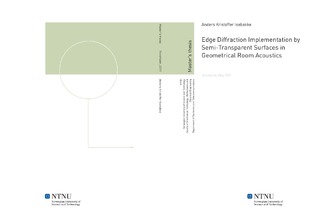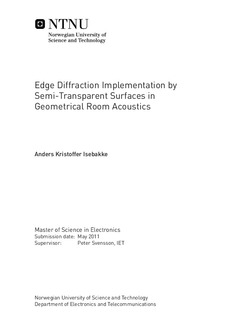| dc.description.abstract | This report presents a potential method to efficiently implement edge diffraction from a noise barrier into geometrical room acoustic softwares. The modelling is based on semi-transparent surfaces, and the classic digital signal processing multipath transmission equation has been employed to describe in a mathematical term the presented method. The basic idea is to subdivide the noise barrier into a number of subareas, and then give each subarea an optimalized transmission coefficient for building the best possible output impulse response.To evaluate the proposed semi-transparent modelling, a Matlab simulation model of an infintite noise barrier case has been developed, and the corresponding simulations have been compared with the ideally correct solution. Accordingly, it is stated that there seems to be a clear positive potential in the proposed modelling technique. However, the results also reveal a somewhat instability in the modelling, which is expected to appear mainly for rare critical source and receiver positions.A main goal has been to develop a method that can easily be implemented in the existing calculation algorithms of today's commercial software developers. For verification, the proposed modelling has by discussion been associated with the often employed diffuse rain method. However, since no true implemenation in geometrical room acoustic software has been performed, further studies are required.To maintain efficiency and reliability, another desired outcome of the presented modelling has been that is should function for a general one-to-all source-receiver condition. Surely, the modelling seems to give fairly good results for symmetric source and receiver positions, but as the receiver is moved away from these symmetric conditions some unwanted errors occur, especially at higher frequencies.Main focus has been given to receiver positions located in the shadow zone, but some simulations and discussion has also been given to receiver positions located near the source-receiver sight line - at where direct sound energy contributions are also included and an interference pattern arises. To cope with this interference pattern, a polarity shift is proposed, which gives a clear improvement at low frequencies.One certainly interesting feature of the presented modelling technique is that it involves a broadband-based simulation method, which means that it gives the full frequency response by running only one simulation. Indeed, this is advantageous regarding calculation efficiency, but it does however also introduce some issues regarding a potential future software implementation - as the common case in geometrical room acoustics is to run individual octaveband-based simulations. | nb_NO |

